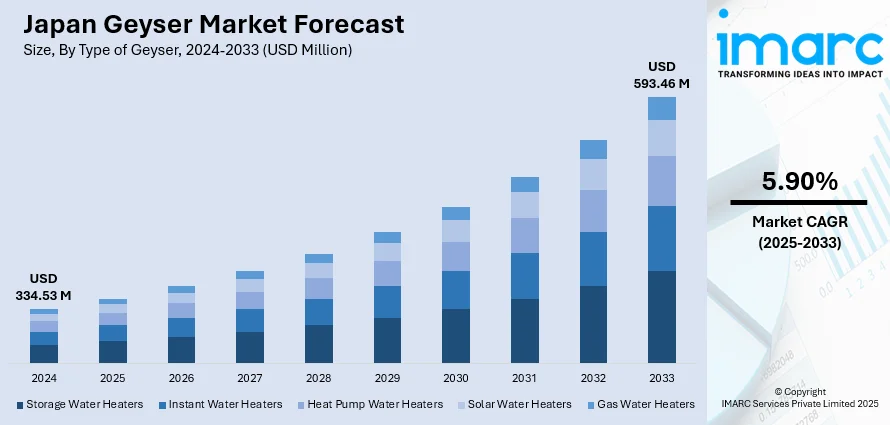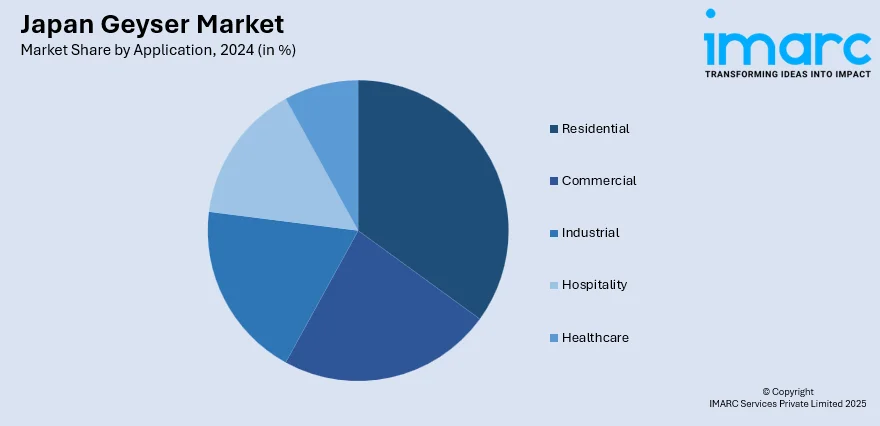
Japan Geyser Market Size, Share, Trends and Forecast by Type of Geyser, Capacity, Energy Source, Application, and Region, 2025-2033
Japan Geyser Market Overview:
The Japan geyser market size reached USD 334.53 Million in 2024. Looking forward, IMARC Group expects the market to reach USD 593.46 Million by 2033, exhibiting a growth rate (CAGR) of 5.90% during 2025-2033. The market is witnessing strong growth led by the penetration of energy-efficient technologies that reduce power consumption and environmental footprint. There is also a demand for small, instantaneous water heaters that offer space savings without sacrificing performance. Also, the incorporation of smart functionality, including remote control and predictive maintenance, delivers improved user convenience and system reliability. These together serve to drive the consistent growth of the Japan geyser market share.
|
Report Attribute
|
Key Statistics
|
|---|---|
|
Base Year
|
2024 |
|
Forecast Years
|
2025-2033
|
|
Historical Years
|
2019-2024
|
| Market Size in 2024 | USD 334.53 Million |
| Market Forecast in 2033 | USD 593.46 Million |
| Market Growth Rate 2025-2033 | 5.90% |
Japan Geyser Market Trends:
Rise in Adoption of Energy-Efficient Technologies
Efficiency in the use of energy is a central concern in the developing Japan geyser market with consumers and authorities prioritizing sustainability. For instance, in November 2024, Panasonic introduced new Eco Cute water heaters for cold climates and boost production to 300,000 units per year—a 1.5x increase—against growing demand for decarbonized heating. Moreover, contemporary geysers have improved insulation materials that minimize heat loss, along with advanced heating elements that maximize energy use while ensuring uniform water temperatures. Intelligent thermostatic controls enable accurate temperature regulation, with the aim of minimizing unnecessary power consumption. This savings not only reduces electricity bills but also contributes to national targets for the reduction of greenhouse gases. Government regulations and incentives for the purchase of energy-efficient appliances further motivate the marketplace. As demand for more eco-friendly options increases among Japanese consumers, energy-efficient geysers become the preferred choice over traditional models. These products play a large role in the consistent Japan geyser market growth, which is part of a broader trend globally toward more sustainable home heating systems. The incorporation of such green technologies in geysers reflects the sector's goal of striking a balance between user convenience and green conscience.

To get more information on this market, Request Sample
Increasing Demand for Instantaneous and Tankless Water Heaters
Within Japan's accelerating metropolitan climate, demand for instantaneous and tankless water heaters is picking up speed at a fast rate as a result of space limitations and energy factors. These geysers provide hot water on demand without needing large storage tanks, hence conserving valuable space within small residential units. The lack of large storage tanks also prevents standby energy loss characteristic of conventional storage systems, resulting in enhanced energy efficiency. Customers enjoy instant hot water access, making every day routines more convenient. Advances in safety features and temperature control have enhanced consumer faith in these solutions. The minimalist aesthetic and simple installation further contribute to tankless geysers as the perfect solutions for Japanese homes today where resource and space optimization is paramount. This is one of the drivers for increased Japan geyser expansion in line with current lifestyle standards and energy conservation needs.
Smart Features and IoT Integration
Smart technology integration is revolutionizing the Japan geyser industry as more and more consumers opt for connected and smart appliances. Smart geysers with Internet of Things (IoT) functionality enable remote control via smartphone apps, enabling users to program heating schedules, control water temperature, and check energy usage in real time. This level of control not only increases user convenience but also facilitates effective energy management consistent with specific usage habits. Additionally, smart geysers can offer predictive maintenance notifications, lowering the prospect of random breakdowns and boosting product longevity. Compatibility with home automation systems makes these products interact smoothly with other smart appliances, encouraging an integrated living space. The take-up of these new technologies is helping to drive the continued Japan geyser expansion, which mirrors the receptiveness of the market to digitalization and customer interest in amplified functionality and efficiency.
Japan Geyser Market Segmentation:
IMARC Group provides an analysis of the key trends in each segment of the market, along with forecasts at the country and regional levels for 2025-2033. Our report has categorized the market based on type of geyser, capacity, energy source, and application.
Type of Geyser Insights:
- Storage Water Heaters
- Instant Water Heaters
- Heat Pump Water Heaters
- Solar Water Heaters
- Gas Water Heaters
The report has provided a detailed breakup and analysis of the market based on the type of geyser. This includes storage water heaters, instant water heaters, heat pump water heaters, solar water heaters, and gas water heaters.
Capacity Insights:
- Below 10 Liters
- 10 to 25 Liters
- 25 to 50 Liters
- 50 to 100 Liters
- Above 100 Liters
A detailed breakup and analysis of the market based on the capacity have also been provided in the report. This includes below 10 liters, 10 to 25 liters, 25 to 50 liters, 50 to 100 liters, and above 100 liters.
Energy Source Insights:
- Electric
- Gas
- Solar
- Heat Pump
- Hybrid
The report has provided a detailed breakup and analysis of the market based on the energy source. This includes electric, gas, solar, heat pump, and hybrid.
Application Insights:

- Residential
- Commercial
- Industrial
- Hospitality
- Healthcare
A detailed breakup and analysis of the market based on the application have also been provided in the report. This includes residential, commercial, industrial, hospitality, and healthcare.
Regional Insights:
- Kanto Region
- Kansai/Kinki Region
- Central/ Chubu Region
- Kyushu-Okinawa Region
- Tohoku Region
- Chugoku Region
- Hokkaido Region
- Shikoku Region
The report has also provided a comprehensive analysis of all the major regional markets, which include Kanto region, Kansai/Kinki region, Central/Chubu region, Kyushu-Okinawa region, Tohoku region, Chugoku region, Hokkaido region, and Shikoku region.
Competitive Landscape:
The market research report has also provided a comprehensive analysis of the competitive landscape. Competitive analysis such as market structure, key player positioning, top winning strategies, competitive dashboard, and company evaluation quadrant has been covered in the report. Also, detailed profiles of all major companies have been provided.
Japan Geyser Market News:
- In September 2024, Mitsubishi Electric Japan introduced the Climaveneta EW-HT-G05, a high-temperature water-to-water heat pump for commercial and industrial use in September 2024. The system augments Japan's conventional water heating systems, including gas geysers, through energy-efficient, environmentally friendly options with a COP of up to 3.77 through R513a refrigerant.
Japan Geyser Market Report Coverage:
| Report Features | Details |
|---|---|
| Base Year of the Analysis | 2024 |
| Historical Period | 2019-2024 |
| Forecast Period | 2025-2033 |
| Units | Million USD |
| Scope of the Report |
Exploration of Historical Trends and Market Outlook, Industry Catalysts and Challenges, Segment-Wise Historical and Future Market Assessment:
|
| Type of Geysers Covered | Storage Water Heaters, Instant Water Heaters, Heat Pump Water Heaters, Solar Water Heaters, Gas Water Heaters |
| Capacities Covered | Below 10 Liters, 10 to 25 Liters, 25 to 50 Liters, 50 to 100 Liters, Above 100 Liters |
| Energy Sources Covered | Electric, Gas, Solar, Heat Pump, Hybrid |
| Applications Covered | Residential, Commercial, Industrial, Hospitality, Healthcare |
| Regions Covered | Kanto Region, Kansai/Kinki Region, Central/Chubu Region, Kyushu-Okinawa Region, Tohoku Region, Chugoku Region, Hokkaido Region, Shikoku Region |
| Customization Scope | 10% Free Customization |
| Post-Sale Analyst Support | 10-12 Weeks |
| Delivery Format | PDF and Excel through Email (We can also provide the editable version of the report in PPT/Word format on special request) |
Key Questions Answered in This Report:
- How has the Japan geyser market performed so far and how will it perform in the coming years?
- What is the breakup of the Japan geyser market on the basis of type of geyser?
- What is the breakup of the Japan geyser market on the basis of capacity?
- What is the breakup of the Japan geyser market on the basis of energy source?
- What is the breakup of the Japan geyser market on the basis of application?
- What is the breakup of the Japan geyser market on the basis of region?
- What are the various stages in the value chain of the Japan geyser market?
- What are the key driving factors and challenges in the Japan geyser?
- What is the structure of the Japan geyser market and who are the key players?
- What is the degree of competition in the Japan geyser market?
Key Benefits for Stakeholders:
- IMARC’s industry report offers a comprehensive quantitative analysis of various market segments, historical and current market trends, market forecasts, and dynamics of the Japan geyser market from 2019-2033.
- The research report provides the latest information on the market drivers, challenges, and opportunities in the Japan geyser market.
- Porter's five forces analysis assist stakeholders in assessing the impact of new entrants, competitive rivalry, supplier power, buyer power, and the threat of substitution. It helps stakeholders to analyze the level of competition within the Japan geyser industry and its attractiveness.
- Competitive landscape allows stakeholders to understand their competitive environment and provides an insight into the current positions of key players in the market.
Need more help?
- Speak to our experienced analysts for insights on the current market scenarios.
- Include additional segments and countries to customize the report as per your requirement.
- Gain an unparalleled competitive advantage in your domain by understanding how to utilize the report and positively impacting your operations and revenue.
- For further assistance, please connect with our analysts.
 Request Customization
Request Customization
 Speak to an Analyst
Speak to an Analyst
 Request Brochure
Request Brochure
 Inquire Before Buying
Inquire Before Buying




.webp)




.webp)












